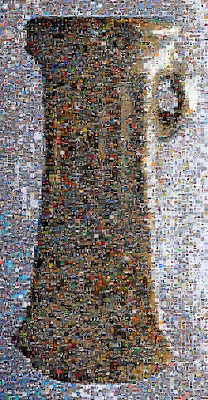This series of art pieces seeks to contest traditional mechanisms for representation and spectatorship by questioning the status that visual images occupy in archaeological discourse. Photomosaics of iconic archaeologists and archaeological objects were constructed through the manufacture of archives and archaeological records of public images available over internet search engines. This digital ‘excavation’ of what is traditionally an unarchived public space marked the beginnings of our digital archaeological practice.
Inspired by Joan Fontcuberta’s series of Googlegrams (2005), we call into question the ways in which archaeologists position themselves and their work within broader society. By conflating archaeological figures with a collage of public images, the pieces reveal the manufacture of representations of archaeological identities and of the artefacts and monuments with which they work. In addition, through the use of the world wide web and freeware, they also challenge the role that digital media are playing in the fabrication of collective archaeological visual memory, interpretation, and mediated information.
We began by considering whether experience is ever truly documented or represented. Each (in)dividual piece subverts and parodies notions of ‘truth’ in archaeology and the veracity of dominant images in the construction of the past and present, memory, identity, gender, emotion and agency. Such a reflexive approach generates connections between unfamiliar essences, resulting in ruptured and fragmented yet dynamic archaeologies, histories and representations.
Previous exhibitions:
Akademia Wychowania Fizycznego, Cracow, Poland, 19-24 September 2006, European Association of Archaeologists
University of Exeter, 15 - 17 December 2006, Theoretical Archaeology Group
This series of exhibitions was made possible by a grant from the Trinity College Provost's Fund for the Visual and Performing Arts and by the support of the Archaeological Illustration Department at Cardiff University. We would also like to acknowledge the support of Chris Witmore, Joukowsky Institute for Archaeology and the Ancient World at Brown University.
















